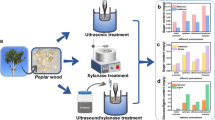Abstract
This study was aimed at evaluating the effect of thermal treatment on the physical and mechanical properties of Eucalyptus grandis wood. Boards were taken from 5.9-year-old E. grandis trees. The boards were thermally modified at temperatures up to 220°C in the Laboratory of Wood Drying and Preservation from UNESP, Botucatu, SP, in Brazil. The results indicated that the thermal modification caused significant decreases of up to: (1) 49.3% and 10.5% in the equilibrium moisture content and in the density of wood, respectively; (2) 53.3% in the volumetric swelling; (3) 52.3% in the modulus of rupture at static bending, without changes in the compressive strength parallel to grain and the respective modulus of elasticity; and (4) 20.7% in the Janka hardness. It was found that the specific gravity and compression parallel to the grain test were not the most suitable ones for evaluating the quality of thermally modified wood.
Zusammenfassung
Ziel dieser Studie war es, den Einfluss einer thermischen Behandlung auf die physikalischen und mechanischen Eigenschaften von Eucalyptus grandis Holz zu untersuchen. Aus 5,9-Jahre alten E. grandis Bäumen wurden Bretter eingeschnitten und im Trocknungslabor der UNESP in Botucatu, SP, in Brasilien bei Temperaturen bis zu 220°C thermisch modifiziert. Die thermische Modifikation führte zu folgenden Ergebnissen: Rückgang der (1) Gleichgewichtsfeuchte um bis zu 49,3 % und der Dichte um bis zu 10,5 %, (2) der Volumenquellung um bis zu 53,3 %, (3) der statischen Biegefestigkeit um bis zu 52,3 % und (4) der Janka-Härte um bis zu 20,7 %. Die Druckfestigkeit in Faserrichtung sowie der entsprechende Elastizitätsmodul änderten sich nicht. Es zeigte sich, dass die Rohdichte und die Druckfestigkeit in Faserrichtung zur Bestimmung der Qualität von thermisch modifiziertem Holz nicht gut geeignet sind.
Similar content being viewed by others
References
American Society for Testing and Materials – ASTM D-143 (1994) Standard methods of testing small clear specimens of timber. Annual Book of ASTM Standard
Associação Brasileira de Normas Técnicas – ABNT NBR 7190 (1997) Design of wooden structures. ABNT, Rio de Janeiro (Ações nas estruturas, propriedades da madeira e dimensionamento nos estados limites de utilização) (in Portuguese)
Bekhta P, Niemz P (2003) Effect of high temperature on the change in color, dimensional stability and mechanical properties of spruce wood. Holzforschung 57:539–546
Bhuiyan TR, Hirai N, Sobue N (2000) Changes of crystallinity in wood cellulose by heat treatment under dried and moist conditions. J Wood Sci 46:431–436
Bhuiyan TR, Hirai N, Sobue N (2001) Effect of intermittent heat treatment on crystallinity in wood cellulose. J Wood Sci 47:336–341
Bodig J, Jayne BA (1982) Mechanics of wood and wood composites. Van Nostrand Reinhold, New York
Brito JO, Garcia JN, Bortoletto Junior G (2006) The density and shrinkage behavior of Eucalyptus grandis wood submitted to different temperatures of thermoretification. Cerne 12:182–188 (in Portuguese)
Calonego FW, Severo ETD, Furtado EL (2010) Decay resistance of thermally modified Eucalyptus grandis wood at 140°C, 160°C, 180°C, 200°C and 220°C. Bioresour Technol 101:9391–9394
Esteves B, Marques AV, Domingos I, Pereira H (2007) Influence of steam heating on the properties of pine (Pinus pinaster) and eucalypt (Eucalyptus globulos) wood. Wood Sci Technol 41:193–207
Products Laboratory Forest (1999) Wood handbook: wood as an engineering material. USDA, Washington
Haygreen JG, Bowyer JL (1996) Forest products and wood science: an introduction. University Press/AMES, Iowa State
Homan W, Tjeerdsma B, Beckers E, Jorissen A (2000) Structural and other properties of modified wood. In: Proceedings world conference on timber engineering, British Columbia
Jämsä S, Viitaniemi P (2001) Heat treatment of wood: better durability without chemicals. In: RAPP AO. Review on heat treatments of wood. In: Special seminar: environmental optimisation of wood protection, Antibes, France. Proceedings… Antibes; COST ACTION E 22:21-26
Kamdem DP, Pizzi A, Jermannaud A (2002) Durability of heat-treated wood. Holz Roh- Werkst 60:1–6
Metsä-Kortelainen S, Anitikainen T, Viitaniemi P (2006) The water absorption of sapwood and heartwood of Scots pines and Norway spruce heat-treated at 170°C, 190°C, 210°C and 230°C. Holz Roh- Werkst 64:192–197
Oliveira JTS (1997) Characterization of eucalypt wood for civil construction. Thesis, University of São Paulo (in Portuguese)
Severo ETD, Calonego FW (2009) Thermal modification process for heat radiation to improve the dimensional stability and biological durability of solid wood. INPI, PI0902/38-8A2 (in Portuguese)
Severo ETD, Tomaselli I (2000) Wood vaporization effect on some mechanical properties of Eucalyptus dunnii. Ci Fl 10:123–133 (in Portuguese)
Unsal O, Ayrilmis N (2005) Variations in compression strength and surface roughness of heat-treated Turkish river red gum (Eucalyptus camaldulensis) wood. J Wood Sci 51:405–409
Vernois M (2001) Heat treatment of wood in France: state of the art. In: RAPP AO. Review on heat treatments of wood. In: Special seminar: environmental optimisation of wood protection, Antibes, France. Proceedings… Antibes, COST ACTION E 22:39–46
Waskett P, Selmes RE (2001) Opportunities for UK grown timber: wood modification state of the art review. Building Research Establishment LTD 203–343, 83p
Weiland JJ, Guyonnet R (2003) Study of chemical modifications and fungi degradation of thermally modified wood using DRIFT spectroscopy. Holz Roh-Werkst 61:216–220
Wikberg H, Maunu SL (2004) Characterization of thermally modified hard- and softwoods by 13C CPMAS NMR. Carbohydr Polym 58:461–466
Acknowledgements
The authors thank the Research Assistance Foundation from São Paulo (FAPESP) and the Coordinator for the Improvement of Higher Level Personnel (CAPES), Brazil, for financial support through grant numbers 05/59074-7 and PNPD-02405/09-1.
Author information
Authors and Affiliations
Corresponding author
Rights and permissions
About this article
Cite this article
Calonego, F.W., Severo, E.T.D. & Ballarin, A.W. Physical and mechanical properties of thermally modified wood from E. grandis . Eur. J. Wood Prod. 70, 453–460 (2012). https://doi.org/10.1007/s00107-011-0568-5
Received:
Published:
Issue Date:
DOI: https://doi.org/10.1007/s00107-011-0568-5




